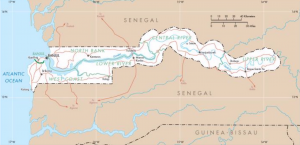Environmental degradation and unsustainable land-use practices are reducing the generation of ecosystem goods and services that support both agricultural productivity and rural livelihoods in The Gambia. Other sources of degradation, such as over-extraction of woodland trees, uncontrolled bushfires, and production of charcoal results in loss of vegetation cover, leading to widespread soil erosion and sediment transfer into the Gambia River. Land degradation is increasingly exacerbated by salinization. In addition to climate-related risks, systemic and persistent gender inequalities in access to water are further challenges to developing food security and climate-resilient agriculture in The Gambia. Post-harvest losses, inadequate storage, limited value-addition and weak marketing are further barriers to food security. The above inter-linked vulnerabilities frequently serve as barriers to climate change adaptation in The Gambia, and need targeted strategies to overcome them.
The overall goal of this project is to enhance adaptive capacity of rural populations in The Gambia through support to climate-resilient and diversified livelihoods.
The target group of the Rural Integrated Climate Adaptation and Resilience Building Project (RICAR) for concrete adaptation activities is smallholder farmers and other vulnerable rural groups, who are already at risk from climate variability and change, with an emphasis on women and youth. The project focuses on a limited number of localities in order to maximize impact in two of the country’s six regions, namely Upper River Region (URR) and Central River Region (CRR). Both regions are highly climate vulnerable, with high levels of poverty, chronic food insecurity, malnutrition, and environmental degradation. They experience considerable barriers to adaptation to climate change impacts, yet have the potential for increased climate-resilient agricultural production, as they have relatively fertile lowland soil, and for livelihood diversification.
The anticipated impact of the project is to benefit at least 30 percent of the population in the two regions of URR and CRR, or 168,000 people, through climate services, knowledge, awareness raising and enhanced adaptation planning activities. Of these 168,000 people, 63,000 will benefit directly from concrete resilience building and adaptation measures, diversified livelihoods developed through value chain and marketing support, and new community-based adaptation plans for their villages. 45,000 of the direct beneficiaries will benefit from activities to increase access to financial services (financial literacy, savings, micro-finance and micro insurance) to enhance investments in climate-resilient agriculture.
| Project Component 1: Develop knowledge and awareness to underpin evidence-based resilience building and adaptation activities, particularly for women and youth, and enhance capacity for systematic sub-national level adaptation planning | USD 741,000 |
| Project Component 2: Implement concrete resilience building and adaptation measures in the project target areas | USD 6,348,916 |
| Project Component 3: Develop incentives, targeting women and youth, and risk transfer mechanisms, targeting smallholder farmers, for sustainable resilience building and adaptive capacity | USD 1,252,084 |
| Project execution cost (including M&E) | USD 874,590 |
| Total project cost (execution included) | USD 9,216,590 |
| UNWFP management fee | USD 783,410 |
| Grant Amount | USD 10,000,000 |
Project Documents
| Attachment | Type | Size |
|---|---|---|
| Project document | 6 MB | |
| Other project order | 181 KB | |
| Inception Report | 776 KB | |
| PPR1 (for web) | 98 KB | |
| PPR2 (for web) | 97 KB |



